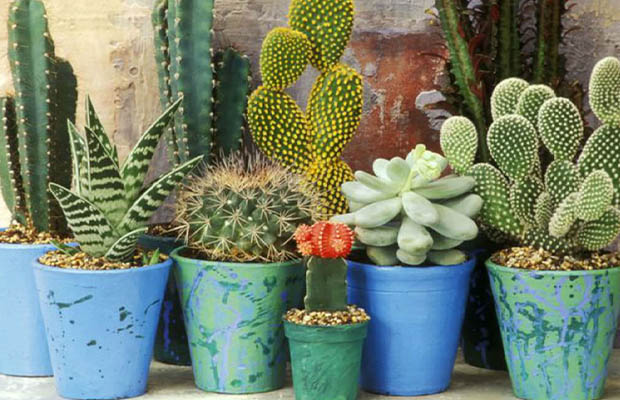People often use the terms succulents and cacti interchangeably, which is scientifically incorrect. It will be easier to identify them and properly distinguish them if you are aware of the relationship between the two. In this article, we’ll go over every important detail.
Are cacti succulents? “Cactus” denotes a botanical family. The term “succulents” refers to a broader category of plants that are members of various botanical families. Succulents are not all cacti, despite the fact that all cacti are generally regarded as succulents.
Table of Contents
What Are Succulents?
A variety of plants are referred to as succulents if they have the capacity to store water in their stems, leaves, and roots. These plants, which are generally low maintenance and quite popular in home gardening, now have increased drought resistance due to this characteristic.
Succulents typically have thick leaves that, when cut open, reveal a gelatinous substance inside. In fact, the Latin word that the name of succulents originated from — succulentus — means “full of juice”.
Related Reading: How Big Do Succulents Get?
What Are Cacti?
We now know that cacti are succulents as well. But what distinguishes them from other succulents? The spines, or is there another cause altogether?
In general, when we think of cacti, we envision a plant with lots of spines, no leaves, and no branches. Additionally, many of the cacti have spines. However, cacti without spines do exist.
It seems that the most distinctive feature of the plant family known as cacti isn’t the presence of spines. Areoles are.
A cactus’ surface has a small bump called an areole that can be light or dark in color and is where the plant’s flowers, hair, or spines emerge.
Areoles being the most distinguishing characteristic of a cactus, it follows that a plant with spines and a cactus-like appearance but no areoles is not a cactus.
A succulent that doesn’t look like a cactus is one that lacks an areole.
Is a Cactus a Succulent?
Although there are about 60 different plant families, succulents do not have their own unique family. Cacti, in the Cactaceae family, make up one of these families. In this way, all succulents and cacti are distinct from one another. A class of plants known as succulents, of which cacti are merely a subcategory, comprises the entire class of plants.
Succulents are all considered water-storing plants. The word “succulent” comes from Latin sucus, meaning juice or sap, and the modern word simply means “juicy.” These plants can be found in dry, arid climates where rainfall is infrequent, so they rely heavily on dew and mist to survive in between.
Succulents have become a popular houseplant in recent years thanks to their distinctive shapes and colors.

Differences Between Cacti and Succulents
Despite their close relationship, there are some important differences between cacti and succulents:
- The leaves of cactus plants are typically few or absent.
- The rounded indentations along the stems of cacti set them apart from the other succulents. These are modified buds called “areoles.” The spines that make cacti famous usually emerge from the areoles.
- Different parts of the world have their own native succulent species that are not cactus. In contrast, only the New World is home to almost all varieties of cacti.
After learning about the non-cactus succulents, it’s usually not too difficult to distinguish them from other plants, just as cacti stand out due to their areoles. Because they store water in their foliage and must be tough enough to survive challenging climates, most sport leaves or modified leaves that, while firm to the touch, have a swollen, juicy look (thus the name, “succulent”) to them. Succulents range from the tiny “living stone” (Lithops) to the giant saguaro that grows up to 50 feet tall at maturity.
The majority of succulent species are not eaten by humans, but some of them are. Purslane is a common lawn weed and succulent that can be used to make salads with its tasty, nutrient-rich leaves. Aloe vera plant juice is another option that some people use.
Succulents that are not cacti include:
- Angelina stonecrop (Sedum rupestre Angelina)
- Autumn Joy stonecrop (Sedum Autumn Joy)
- Chocolate Drop stonecrop (Sedum Chocolate Drop)
- Purple ice plant (Delosperma cooperi)
- Hens and chicks (Sempervivum tectorum)
- Aloe vera (Aloe barbadensis)
- Agave (Agave americana)
- Moss rose (Portulaca grandiflora)
- Flaming Katy (Kalanchoe blossfeldiana)
Examples of Cacti
Although some varieties of cacti and succulents are quite cold-hardy, they are typically associated with warm environments like deserts. In USDA plant hardiness zones 3 through 11, the hens and chicks succulent can be found growing. Among the cacti, ‘prickly pear’ (Opuntia humifusa) can thrive in a wide variety of climates within zones 4 to 10.
Prickly pear grows in clumps up to 14 inches tall and nearly twice as wide. Three-inch yellow flowers are produced along with a more prostrate growth habit as the plant ages. The plant might start blooming in the summer or late spring, depending on where you live. The fruit from which the plant derives its name is called a “tuna.”
The flat, bluish-green vegetative parts are referred to as nopalitos or “pads.” The pads look like a collection of bunched-up, spiny beaver tails. In fact, the Opuntia basilaris species is actually called the “beavertail cactus.”
Other examples of cacti include:
- Crown cactus (Rebutia)
- Ball cactus (Parodia)
- Uebelmannia cactus (Uebelmannia)
Uses for Cacti and Succulents
These tough, diverse, sometimes beautiful plants might prove useful to you as:
- Xeriscape plants for use in sunny, dry areas
- Plants to grow in between garden stepping stones (in the case of short succulents such as Angelina stonecrop)
- Subjects for your terrarium
- Houseplants that freshen the atmosphere
How to Take Care of Succulents?
Cacti and other succulents work well as houseplants. They require very little maintenance if they are potted and cared for properly (in accordance with their family and variety). In reality, overwatering and infections are the main reasons why succulents die. As long as they receive enough sunlight, they simply prefer to be left alone.
The main piece of advice for keeping your succulents healthy and happy is to make sure the potting mix is completely dry before watering, though specific care instructions vary depending on the variety. This usually equates to once per week, but it also depends on how much drainage, humidity, heat, and sunlight each plant is receiving. You’re probably overwatering your plant if the leaves start to feel mushy or soggy.
Although not always in direct sunlight, most succulents and cacti enjoy bright light. To get the most sunlight possible if you’re keeping them indoors, place them close to large, bright windows. For a few weeks at a time, move them around your house to observe how they respond to various levels of sunlight. If the leaves of your plants start to sag or the flesh starts to turn pale, they may not be getting enough sunlight.
Any cactus or succulent needs a well-draining potting mix and container to survive. Succulents can typically be planted in sand, pumice, perlite, potting soil, or a combination of any of these. To help water drain away from the roots and soil, think about packing the bottom of your container with rocks or gravel.
Related Reading:
Propagating Succulents and Cactus
Similar to other plants, succulents can reproduce by seed. But because wind frequently blows the tiny seeds far from places where they can grow, they have had to adapt. In general, the term “propagation” describes a process of growing additional plants from a portion of the original.
Succulents can grow in a number of ways, either naturally or by a gardener intentionally trying to increase the variety of their garden.
A stem or offshoot from a parent plant is propagated vegetatively when it is replanted and develops its own roots from the cut end after a few weeks. Individual leaves may also do this; they may develop roots without first being replanted in soil. Both of these techniques need a few days of healing (or callousing) to seal themselves off from potential soil and water infections before the roots can form.
Contrarily, division is a form of plant propagation in which the parent plant creates a pup, also known as a plantlet or chick, near its base. After two to three weeks of growth close to the parent, the pup can be transplanted because it is an independent little plant.
Related Reading:
FAQs
Which Succulents Are Not Cacti?
- Angelina stonecrop (Sedum rupestre Angelina)
- Autumn Joy stonecrop (Sedum Autumn Joy)
- Chocolate Drop stonecrop (Sedum Chocolate Drop)
- Purple ice plant (Delosperma cooperi)
- Hens and chicks (Sempervivum tectorum)
- Aloe vera (Aloe barbadensis)
- Agave (Agave americana)
Do Succulents Have Thorns?
Some succulents are often mistaken for cacti because they have thorns or spines, but these characteristics do not automatically qualify a succulent as a cactus. In order to tell the two apart, look at the areoles.
Is Aloe Vera a Cactus Or Succulent?
Aloe vera is a succulent plant species of the genus Aloe is a stemless or very short-stemmed plant with fleshy, thick, and greenish-green leaves that fan out from the stem at the center of the plant. The leaf’s edge is toothed and serrated.
Is Jade a Succulent Or a Cacti?
Nevertheless, the jade plant is a tropical succulent, which is not to be confused with a desert cactus, although cacti may be distant relatives of this plant. In order to prevent the jade plant from shriveling from dehydration, it must receive regular irrigation, and its soil must always be kept just slightly moist.
Conclusion On Cacti Vs. Succulents
I hope that now that the differences and similarities between cacti and succulents have been clarified, you feel more comfortable telling them apart.
Although deserts are frequently associated with cacti, this is not the only environment in which they can be found. Similar to this, arid, hot, and dry regions are where you can find succulents.
Remember that a succulent that resembles a cactus in every other way except for the absence of its areoles is merely a succulent that “poses” as a cactus.
Make sure to become familiar with the needs particular to your variety, whether you have a succulent, a cactus, or both, to ensure you meet all of their needs. If you want to learn more about succulent, read our post on 20 popular succulents types.

















